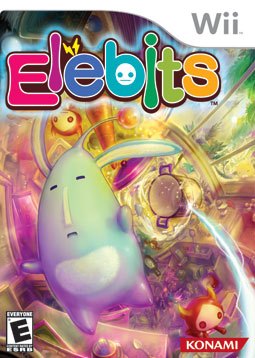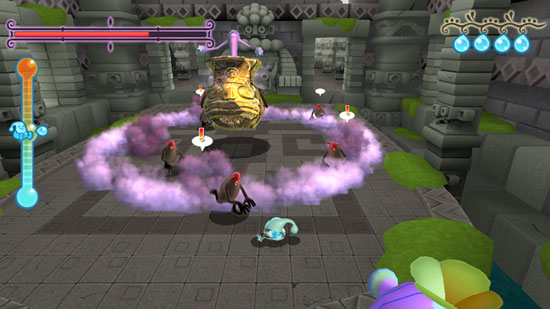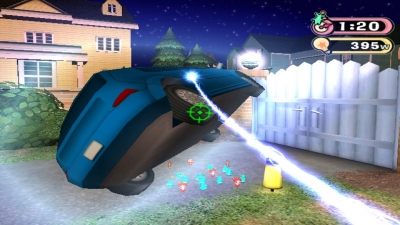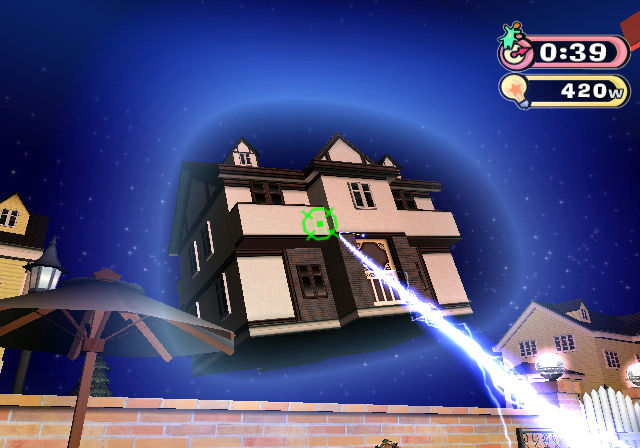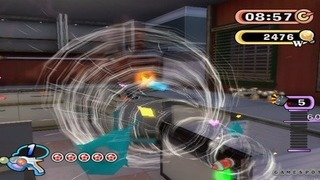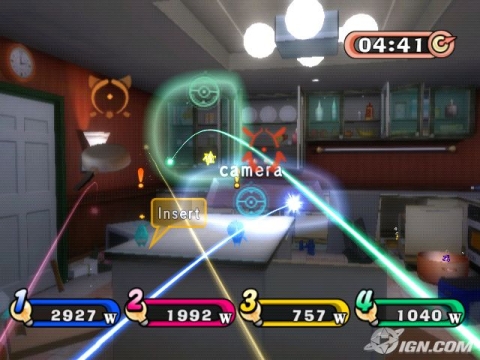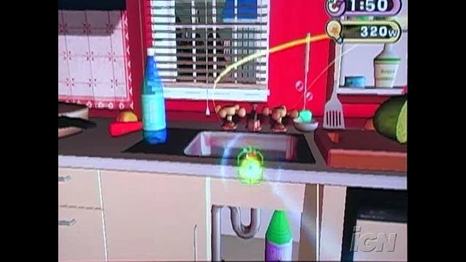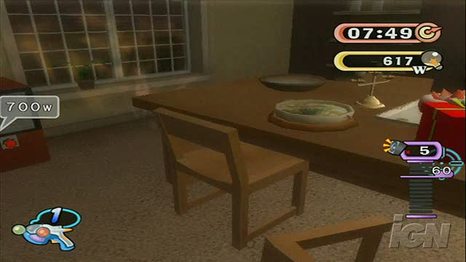Elebits is an action first person shooter role playing game developed by Konami for the Nintendo Wii which was released in late 2006.
Full Review
Elebits Review
By, Felipe Faria Lemos
Backdrop
.hack Part 1 Infection (Dot Hack) begins with a bang. Something disastrous happens to your character‘s real world friend, while innocently playing a 20 million-subscriber base, wildly popular online RPG game (MMORPG), The World. To unravel the mystery of your friend’s misfortune, you become an online, ingame rogue hacker, exploring every corner of The World, even some virus-infected ones.
The hero is armed with the special skills of Data Drain and Gate Hack, and some colorful, talented fellow adventurers to fill the two other available party slots. Different adventurers must accompany you depending on the plot‘s development. You have some control over the others in your party, including upgrading them through trades or gifts. You can play only a single class, Twin Blade. Other characters are from different classes, with varied strengths and weaknesses, from a mage type (Wavemaster) to a bully (Heavy Axeman).
Gameplay
Gameplay takes place in three principal areas – towns, fields, and dungeons. Towns house The World’s servers. There, the player can save the game, buy magic scrolls and useful and unique items, store items, buy equipment, and talk and trade with lots of other players in character online. One town has an unusual ranch to check out, a patent homage to an enduring feature of just about every Final Fantasy.
The town’s Chaos Gate provides instant teleportation to a particular wide-open Field, containing monster encounter hotspots, a mystical spring, treasure, and lots of mysterious food. You enter three distinct keywords, some known at the game‘s onset, and others learned through play. Whatever keywords are entered, the difficulty level of the destination is helpfully revealed. This prevents a low-level party from being massacred. Once the keywords are entered, you travel through the Chaos Gate. (You can enter specific keywords learned to continue the plot, do side quests, or do unlimited exploring. Or, you can instruct the Gate to enter random keywords, and take your chances. There‘s also an option to enter any keywords you wish from a word list.) Every Field houses a single Dungeon. The dungeons, where you spend much of the game fighting for your life, are not overly large in size, and always range between three and five average levels.
Many have compared Dot Hack to Phantasy Star Online Episode I and II (PSO) on the Gamecube. Let us gently discredit this. We feel Dot Hack has far better graphics than PSO. The Fields and Dungeons contain many colorful, over stylized backdrops and settings, including weather effects. Dot Hack’s monsters resemble the beautifully-drawn monsters of the later Final Fantasy’s. Dot Hack’s world is gigantic with a seeming infinite number of locations to explore. PSO’s world is relatively small, and plot is threadbare, with meaningless, though fun, side quests, which instill no enthusiasm in the player. Dot Hack’s plot is deep and complex, with each subplot advancing the story just a little bit further. (Remember though, the end of this game in no way comes close to wrapping up the story, to be completed in the three games to be released later this year.) One visual treat, however, was lifted directly from PSO – the cascading rings that accompany the teleportation of characters to and from different areas.
Combat
Dot Hack’s combat engine can best be described as modified real-time. Much like the action-RPG, Kingdom Hearts, button mashing can be effective to beat monsters. Monster combat icons appear as large yellow twirling landmarks. As you approach, the landmark dissolves, monsters come at you big-time, and, undoubtedly, players will feel a healthy adrenaline rush. Some of Dot Hack’s many monsters do not stand around waiting to be pummeled, rather some you need to catch. Dot Hack lets you turn combat almost into a turn-based affair. The player needs only to hit Triangle in the middle of battle to pause the game instantly. From there the player can give orders to the others in the party, anything from healing someone, reviving another, casting a spell, designating a target monster. Without jeopardizing your party from the hailstorm of monster blows, combat becomes a calmer, more strategic, experience. This will help the many action-challenged. Camera angles play a big role in successful combat. You must be facing a monster to do any damage. As in many games, manipulating opposing environmental elements, like fire vs. water, is a key to successful monster combat.
Dot Hack’s cyberspace setting provides a wealth of Wow-inducing outbursts. The Data Drain option in combat is a great example. When a monster’s approaches zero, the player can Data Drain to reduce a horrendous, gigantic steel robot, for example, into a sniveling, puny monster, easily defeated with a single blow. Data Drain always results in a nifty, rare item or essential Virus Cores so you can Gate Hack areas of The World now closed, but needing investigation. One bad side effect – if you defeat, a Data Drained monster, but a single experience point is earned. One REALLY bad side effect – if you Data Drain too often without giving the skill a rest, you may overload and explode. Game Over. In the case of Boss monsters, Data Drain works the same, but what remains is no sniveling puny monster, but a full-blooded slightly less tough monster. All of this makes for interesting and captivating combat, a large part of the game.
Fresh Features
Dot Hack is replete with new and interesting features that kept us riveted.
To start, the entire background and story of a real world gamer becoming a rascal hacker, penetrating deep into a virus-infected online game, is quite novel. Combine this with Dot Hack’s emulating the look and feel of an online game universe. (Message traffic on the web shows many gamers mistakenly believe Dot Hack is a real online MMORPG, along with monthly fees! No real Internet connection is required.)
Just like in the real word, Dot Hack replicates your excitement level when “New” appears before a popular forum or on your email screen. Some of the game involves receiving emails as the plot develops, as well as new, crucial information surfacing on The World’s Board. (Look out for emails challenging you to a strange game of Tag.) The online game world looks very familiar with a bunch of characters wandering around the game’s towns, with the ubiquitous balloon icons talking typical “trash” to each other, even criticizing “newbies“.
Combat grippingly called for surprisingly strategic decision-making to succeed, not related to the usual attack or defend choices. Do you go for experience and upgrade your character or try for some special equipment or a Virus Core, vital to Gate Hacking? The innovative control of other party members became second nature to us after some practice. The game rewards a player taking chances, like entering a Field or Dungeon rated 5 levels above the player’s current level. On the other hand, the game scoffed at players entering areas much lower rated the their current level, by awarding negligible experience points for victory.
Dot Hack takes progress reports to a new level, by slowly unlocking books that contain much in the way of statistics and information. There’s even a monster compendium with tips for defeating them.
Some might complain about the minimal “Save Game” ability, but we thrived on it. You explore a very hostile cyberspace environment without the facility to save. Only in a server-hosting town is saving possible at the local Recorder. We may be a solitary voice in the Wilderness, but we like this throwback to the good old RPG days. Those of you old enough to remember the Wizardry series, may recall those fingernail-biting multi-combat treks back to the Castle just to save the game. In case you’re really stuck deep in a dungeon, a common item will teleport you to the outdoor field, from where you can simply gate back to town from the command menu.
Many pieces of equipment come with distinctive powerful attack, healing, and status skills, essential to combat dominance. The player must tradeoff whether to equip something that will raise defense or offense or something less vigorous that lets you use a powerful skill. Trading is the most successful way to upgrade equipment.
In a first, Dot Hack comes with a 45 minute anime video. This gives some great background on what’s going on in The World, as well as provide clues for completing the game. In a nice twist, voiceovers for game speech can be set for Japanese or English presentation. Listening to the authentic Japanese voices really keeps you glued to the game.
Though some may scoff at what follows as meaningless, we liked the game’s unlocking of some nifty new “toys” to like, some only available when the game is cleared. You can unlock many different background music play lists. Tired of creepy tunes, just switch to something more upbeat, or futuristic. Just like real world gamers, who constantly change their desktop wallpaper, new and different wallpapers are unlocked along the way. Some are concept art of characters, while others are full blown anime renditions of the characters. This makes for great fun, and seems to pump additional energy into the game. As you progress over a dozen special cut scenes or movies will become viewable after defeating the game.
Though Dot Hack’s extras and new wrinkles enhance the RPG game experience, much of the gameplay will ring true to those who enjoy RPG‘s. Expect plenty of exploration in a huge 3D world, frequent monster combat, tons of treasure to earn and discover, upgrading your character’s weapons and armor, and needing to level before tackling pivotal story dungeons. The status screens for the characters and all equipment are well laid out and easy to grasp.
Time for Completion
Game length in hours always concerns many purchasers. A short RPG normally takes a lot of flack, and many online are asking about Dot Hack‘s time for completion. (Some have questioned whether Bandai should have released a single 80 hour game for $50, rather than four 20-hour games for $200 for a single story. This matter is beyond the scope of this review, but our high opinion of this game as a standalone is obvious.) Our experience, playing the plot without doing side quests or extra exploration, is in the 12 to 15-hour range. Players side-questing and extensively exploring, aside from the main plot, can expect to spend 25 hours to complete the game. You can even continue to advance your character, after game completion, to get a jump start on Part 2 due in May. In the next game, your character can be imported from Part 1.
Furthermore, imagine trying to explore every nook and cranny of the fields and dungeons accessible by a large number of 3-word combinations. Doing that would put the game in the 50-hour range, if not more. However, at a certain point, new items dry up, and a single experience point is earned for any defeated monster, no matter how tough.
Shortcomings
While, as is evident above, there is much to recommend in Dot Hack, certain concerns to varying degrees deserve mention.
From the “Why oh why did they leave this out?“ File. Pregame game board traffic and information about the Japanese version released months ago had many salivating for replaying the game in “parody” mode. This mode apparently converted all Dot Hack’s game world characters into satirical comedians. Sorry to say, this highly-anticipated feature is missing from the version released here.
The game requires massive amounts of button pressing. Every item or treasure uncovered from combat victories or exploration (opening chests, searching expired adventure remains, collecting food for Grunty’s, as examples) must be confirmed with a button press. When there could be 50-100 such occurrences in a single dungeon or field, over the course of the game, finger cramps seem inevitable. Baldur’s Gate: Dark Alliance also required lots of bashing for buried treasure and chests, but the items literally flew into your inventory, a much better way to handle this.
The manual is woefully terse and lacking in some crucial information and guidance. While the ingame tutorials fill in many of the gaps, one extremely important gameplay feature is missing from both the manual and tutorials – instructions on control your characters directly during combat.
Final Word
We got a kick out of Dot Hack. The feeling of “just one more dungeon” dominated our lives for the 3 days to completion. The engaging environment held our attention without much effort. The strategic nature of combat, plus the convoluted plot kept us going for hours on end. The constant unlocking of both frivolous and important gameplay features created a “what’s next” anticipation. Now, if I could only read Japanese better, Dot Hack Part 2 is already out in Japan!
Final Grade: B
| The Nintendo Wii has become more and more a platform for different and original ideas, geared mainly towards gameplay (and leaving graphics concerns behind). Following Nintendo’s innovative philosophy, Konami delivers Elebits, a brand new IP exclusive on the Nintendo console, which stands as one of the best games to be picked up for the Wii in the current line-up. |
|
|
Elebits is a great experience on the Nintendo console, and although flawed in some aspects, it is one of the most unique games on any system. The Wii remote is definitely a revolutionary piece of gaming equipment, and through it is how Elebits truly shines. Graphically speaking, the game is a disappointment. There seems to be no reason this game wouldn’t run just as well on a GameCube as it runs on the Wii. Overall, the sharpness is below average and even the frame rate drops at times Even though it is not a major problem, it can hinder the experience a bit. There is a great variety of items, but not a great variety of areas, and both of these look as though they belong on the past generation of consoles. The story is told using still, amazing artwork in a high resolution and effects, which looks much like a slide show. It works fine, and the artwork in the game is impressive. Rather unimpressive however, is the awful voice work found in the game. The voice of the main character is so bland and boring, you can’t tell if it is a boy or girl, and makes the player want to skip the story portion. It sure detracts from the overall appeal of the story sequences.
|
| Talking about the story, it goes a bit like this: the Elebits supposedly are the main source of energy in this alternate world, where fossil fuels and nuclear power are non-existent. All power is drawn from them, and they have been friends with people since time immemorial. However, one stormy night this all changes, and the Elebits go into hiding. This is where the game starts off, with the main character, Kai, a 10-year-old boy, picking up his dad’s capture gun (who, along with his mom, is a world-famous Elebits researcher) and searching for Elebits around the house in order to watch his favorite TV show. |
|
As said before, graphics was not the main concern, and it can easily be overlooked, simply because playing the game is fun. If the graphics disappoint, the gameplay more than makes up for it with its amazing sense of immersion and reaching a new level of interactivity. The folks at Konami really did a great job with the physics in the game, and the vast majority of the objects feel like they are quite real and react as expected when picked up. However, the objects can be thrown freely around, and few of them actually break, with most just bouncing as if they were rubber balls. This does not spoil the fun though, and making a huge mess of the rooms you go through is a lot of fun in itself. The number of objects on the screen at a certain point can be vast, and it only adds to the mess you can create. After some practice, using the capture gun will become natural to the player, and you will find yourself capturing Elebits, throwing a TV across the room, practically juggling smaller items, and opening doors in a believable manner. There are also many different items found throughout the house that can be activated or used along with the capture gun that spice things up. Some of them are used to attract the Elebits, or cancel the noise you create, others, such as the homing laser, help you capture Elebits faster. Fortunately, the majority of these items are fun to use, and really are useful, creating a sense of accomplishment since you are racing the clock to find Elebits.
|
|
| The sound in the game is fine, and does not add or detract from the overall quality of the package. The sound effects are varied, and do a good job in matching the objects they are linked to. The music, on the other hand, is very generic, and will not get stuck in your head anytime soon. Before starting a mission, the player has the chance to choose the song track desired, which only matters if you truly dislike one of the plain tracks available. Nevertheless, the laser sound that plays when the player shoots the capture gun repeats so frequently, that a player may find himself or herself just tired of listening to it. |
|
|
Overall, Elebits is an above average game, mainly due to its new and interesting game mechanics, and the ability to create huge messes is a lot of fun. However, where it shines in the fun factor, it is quite dim when it comes to graphics and sound. In the end, it turns out to be a good choice in order to enjoy a new (and definitely different) game experience. Moreover, there is a lot of content to be explored (with a browser of all the objects you found, with detailed descriptions), movie gallery, multiplayer modes, online features (share levels and screenshots, which are interestingly limited to sending one daily), and extra missions. All this certainly bumps up the replay level, and will keep dedicated players coming back. Elebits is a fine example of what a first wave game can be in a new generation of consoles, and hopefully in the future we will see more games with the gameplay quality of Elebits, but more polished around the edges.
|

